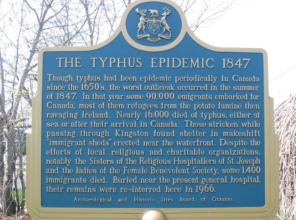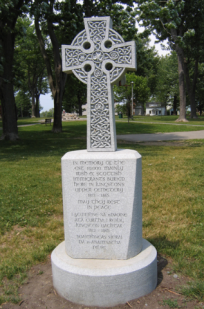On the 18th of September 1992, a 158-year-old headstone was dug up in a Kingston playground, (McBurney Park) nearby in the grass, lay a human femur. Skeleton Park is the popular name given to this area because of the frequent unearthing of human remains. The park was in use as a city cemetery for Catholics and Protestants from c. 1813 until 1865 and was known then as Kingston’s Upper Cemetery. Originally a burial ground for soldiers, it quickly filled to capacity with an estimated 10,000 burials over the half century it was in use as a cemetery.
Kingstonians suffered through at least 6 major epidemics including:
- The malaria outbreaks which killed a large number of labourers working on the Rideau Canal (1827 till 1832),
- The cholera epidemics which killed an estimated 10% of Kingston’s population (1832 and again in 1834),
- The typhus epidemic which killed over 1500 Irish immigrants and their. Kingstonian care givers (1847 / 48).

Although typhus (also called ‘ship fever’) epidemics had occurred in Canada since the 1650’s, the outbreak in the summer of 1847 was by far the worst. That year an estimated 50,000 Irish, bringing with them the dreaded, contagious typhus disease, came through Kingston. Having survived a perilous journey crossing the Atlantic Ocean in coffin ships and having witnessed the horrors of the quarantine station at Grosse Isle, they arrived in Kingston in overcrowded barges. They witnessed thousands of their fellow travelers, family and friends, weakened by hunger, die from the typhus throughout the long journey.
Many Kingstonians opened their homes to take care of the sick and dying Irish immigrants and in doing so the typhus spread throughout Kingston. An estimated 300 Kingstonians, having contacted typhus, died in 1847. Most would have been buried either in the mass grave at Kingston General Hospital or in McBurney (Skeleton) Park, Kingston’s Upper Cemetery from 1813 till 1865.

St Mary’s Cemetery and Cataraqui Cemetery opened in 1856 and 1853 respectively. In March 1865, a bylaw passed by City Council came into effect, preventing any further burials taking place in Skeleton Park. Over the years, letters appeared in the local newspaper protesting the desecration by owners who allowed animals to graze, as well as various acts of vandalism, in the cemetery. Due to this, the Catholic, Presbyterian, and Anglican church proposed that the bodies be exhumed and re-interred in St. Mary’s and Cataraqui Cemeteries, and the area be converted to a city park. On the 27 May 1893, the land was officially granted to the city by an act of the province of Ontario. The land was granted however with strict conditions set out in schedule B of the act. They are as follows:
LIST OF CONDITIONS
- The fences along the streets to be taken down, the surface of the grounds to be leveled and made into a green sward.
- The tombstones to be laid level with the surface of the ground immediately over the graves which they mark and a plan to be made indicating the position of each known grave.
- Gravel or cinder footpaths to be made through the grounds but no driveways.
- The grounds to be planted with trees, shrubs, and flowers.
- The grounds to be maintained in good order as a public square and the same as other like public squares.
- Proper police protection to be provided by the Police commissioners.
- No walk shall be made over any grave.
- The bodies interred in the burying ground to be taken up and removed to another burying ground. The said removal to be done at the expense of the city and all applications of relatives or individuals are by said city to be entertained.
Province of Ontario (1893), 288
Catholics were to be re-interred in St. Mary’s Cemetery and Anglicans and Presbyterians in the Cataraqui Cemetery, but only upon request.
The citizens of Kingston reacted to the re-internment in a variety of ways. Some approved, others strongly disapproved, either on religious grounds, or due to health risks that disinterred bodies might represent. A Mister Adfit and his workmen billed the city for the removal of 540 bodies, plus an additional 167 boxes of remains. Some of the graves, when opened, were empty and this made some citizens suspect that periodically remains were secretly sold by body snatchers to Queen’s medical dept. Other graves contained up to 11 bodies. In other cases, bodies of loved ones could not be located. Out of an estimated 10,000, (i.e. approximately 4,000 Catholics, 4,000 Anglicans, and 2,000 Presbyterians) less than 1,000 bodies were removed from McBurney Park. The reinternment of some of the bodies was carried out over approximately 3 weeks and ended on the 15th of June, 1893. During this work, the city announced to the press that plans were underway to erect a monument in the park, dedicated to the memory of the deceased.
Work on the park stopped early in 1894 and on the 6th of February, 1894, Kingston’s Upper Cemetery was officially named Frontenac Park. On the 26th of February, 1965, the Committee on Parks and Property recommended that the park be renamed McBurney Park in honour of Mr Jim McBurney. He had been principal of the nearby Central Public School for 25 years.
The Kingston Irish Folk Club, Tir na nOg Irish Pub, Kingston Brewing Company and the 2002 City Council completed the work of the 1894 council by erecting a 7ft high granite Celtic Cross Monument in Skeleton (McBurney) Park on Thursday 28th Feb 2002. During a memorable ceremony, on what must have been the coldest day of the decade, the Celtic Cross monument was blessed and dedicated by Archbishop Spence, Rev Terry Deline, Rev Borden Purcell and Rev Lincoln Bryant on Sunday the 10th of March, 2002. Neil Patterson presented the historical background and Aralt Mac Giolla Chainnigh piped a lament. Chris and Stephanie Harris were in period costume. John Gerretson, MPP, and Mayor Turner, assisted by Jeff Girling and Tony O’Loughlin, unveiled the monument.

Following the ceremony many of those present participated in the annual St Patrick’s Week parade. The parade assembled at the Skeleton Park Celtic Cross and then proceeded down Princess Street.
The Celtic Cross monument makes visitors to the park, aware of its history as a major burial ground. While the vast majority of those buried in the park were from Ireland or Scotland the monument is, of course, dedicated to the memory of all those buried in Kingston’s Upper Cemetery.